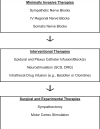Complex Regional Pain Syndrome: Practical Diagnostic and Treatment Guidelines, 5th Edition
- PMID: 35687369
- PMCID: PMC9186375
- DOI: 10.1093/pm/pnac046
Complex Regional Pain Syndrome: Practical Diagnostic and Treatment Guidelines, 5th Edition
Abstract
There have been some modest recent advancements in the research of Complex Regional Pain Syndrome, yet the amount and quality of the work in this complicated multifactorial disease remains low (with some notable exceptions; e.g., the recent work on the dorsal root ganglion stimulation). The semi-systematic (though in some cases narrative) approach to review is necessary so that we might treat our patients while waiting for "better research." This semi-systematic review was conducted by experts in the field, (deliberately) some of whom are promising young researchers supplemented by the experience of "elder statesman" researchers, who all mention the system they have used to examine the literature. What we found is generally low- to medium-quality research with small numbers of subjects; however, there are some recent exceptions to this. The primary reason for this paucity of research is the fact that this is a rare disease, and it is very difficult to acquire a sufficient sample size for statistical significance using traditional statistical approaches. Several larger trials have failed, probably due to using the broad general diagnostic criteria (the "Budapest" criteria) in a multifactorial/multi-mechanism disease. Responsive subsets can often be identified in these larger trials, but not sufficient to achieve statistically significant results in the general diagnostic grouping. This being the case the authors have necessarily included data from less compelling protocols, including trials such as case series and even in some instances case reports/empirical information. In the humanitarian spirit of treating our often desperate patients with this rare syndrome, without great evidence, we must take what data we can find (as in this work) and tailor a treatment regime for each patient.
Keywords: CRPS; Complex Regional Pain Syndrome; Diagnostic Criteria; RSD; Reflex Sympathetic Dystrophy; Treatment Guidelines.
© The Author(s) 2022. Published by Oxford University Press on behalf of the American Academy of Pain Medicine.
Figures




References
-
- Stanton-Hicks M, Baron R, Boas R, et al.Complex regional pain syndromes: Guidelines for therapy. Clin J Pain 1998;14(2):155–66. - PubMed
-
- Harden RN, Oaklander AL, Burton AW. et al.; Reflex Sympathetic Dystrophy Syndrome Association. Complex regional pain syndrome: Practical diagnostic and treatment guidelines, 4th edition. Pain Med 2013;14(2):180–229. - PubMed
-
- Stanton-Hicks M, Jänig W, Hassenbusch S, Haddox JD, Boas R, Wilson P.. Reflex sympathetic dystrophy: Changing concepts and taxonomy. Pain 1995;63(1):127–33. - PubMed
-
- Janig W, Stanton-Hicks M.. Reflex Sympathetic Dystrophy: A Reappraisal. Seattle: IASP Press; 1996.
Publication types
MeSH terms
LinkOut - more resources
Full Text Sources
Other Literature Sources
Medical

